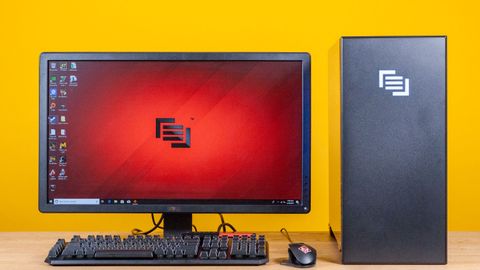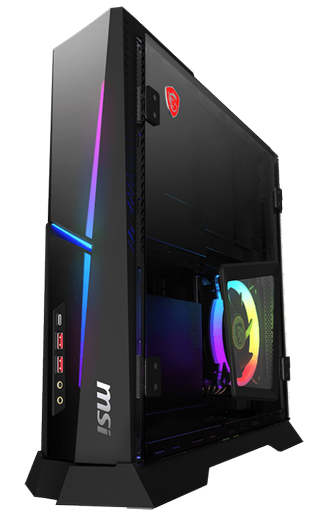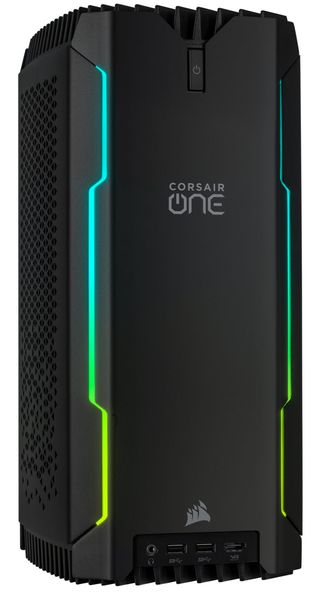Tom's Hardware Verdict
If you’re after a smartly assembled, high-end gaming and productivity rig that ships fast and doesn’t cost much more than its components, Maingear’s Vype shouldn’t disappoint, unless you prioritize a flashier, more premium case.
Pros
- +
Surprisingly affordable for the components
- +
Promised two-day shipping
- +
Clean build
- +
Quiet operation
- +
Included USB adapter adds Wi-Fi, but not Bluetooth
Cons
- -
Core i9 CPU is overkill for gaming
- -
Case feels a bit plain
Why you can trust Tom's Hardware
If you’ve ever ordered a custom-configured computer, chances are you’ve had to wait, and wait and wait some more for your shiny new system to arrive. It’s not uncommon for a month or more to pass between when you click the buy button to when your PC arrives at your door.
Maingear aims to alleviate the pain of waiting with its latest Vybe desktop. You can still customize it to your specific needs or budget. If you max out the system configurator with a pair of Nvidia RTX Titans, custom paint and cooling and an Intel Core i9-9980XE, you’ll be looking at a bill north of $15,000.

But down in the real world, where most people’s budgets reside, a price range between $699 and $2,499 probably encompasses what most of us can pay for a gaming PC. The top of that range is the asking price for Maingear’s “Stage 4” Vybe, which we’re looking at here. Stage 4 is the highest-end of four pre-configured options that the company says it can ship out the door within two business days of your order. Its Intel Core i9-9900K CPU is a bit of overkill for strictly gaming purposes, but paired with an RTX 2080 graphics card, 16GB of memory and a speedy 512GB NVMe SSD (and a 2TB hard drive), it makes for a very capable system that’s not much pricier than what you’d pay for parts and OS alone.
Maingear Stage 4 Vybe Gaming Desktop Specs
| Processor | Intel Core i9-9900K |
| Motherboard | MSI Z390 A-Pro |
| Memory | 16GB HyperX Predator (2x 8GB) |
| Graphics | Nvidia GeForce RTX 2080 (8GB GDDR6) |
| Storage | 512GB Intel 660p M.2 NVMe SSD, 2TB HDD |
| Optical Drive | ✗ |
| Networking | Gigabit Ethernet, USB Wi-Fi adapter |
| Ports | Front: (3) USB 3.1 Gen 1 Type-A, (1) USB 3.1 Gen 1 Type-C, headphone jack, mic jackRear: (2) USB 2.0, (1) PS/2, (1) USB 3.1 Gen 2 Type-A, (1) USB 3.1 Gen 2 Type-C, (2) USB 3.1 Gen 1, 7.1 Surround Audio (Realtek ALC892 Codec) |
| Video Output | (3) DisplayPort (1) HDMI (1) VirtualLink |
| Power Supply | 750 Watt EVGA SuperNOVA B3 80+ |
| Case | Vybe matte black with tempered glass side panel |
| Operating System | Windows 10 Home 64-Bit |
| Extras | ✗ |
| Dimensions (HxWxD) | 18.6 x 8.7 x 17.9 inches / 42.7 x 22.1 x 45.5cm |
| Price As Configured | $2,499 |
Design

In terms of looks and functionality, the Vybe is fine, if not particularly flashy or premium feeling. It’s a boxy black mid-tower with an RGB-lit Maingear logo on the front and a left side panel that’s tempered glass with a metal frame.
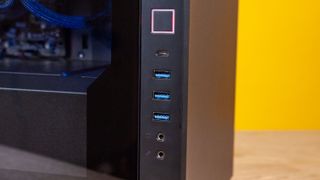
Aside from the glass side panel, the chassis is mostly steel, with a plastic front and feet. Intake is handled via slats that run up the right-front edge, while the left edge houses three USB 3.1 Gen 1 Type-A ports, one USB 3.1 Gen 1 Type-C and a pair of audio jacks. There are two removable dust filters, one on the top and one on the bottom. But the top filter is hard to remove--especially if you have stubby fingers like me. And the bottom filter slides out the back, which means if you have the case up against a wall, you’ll have to turn the system or pull it forward several inches to remove and clean the filter.
Maingear actually sells the Vybe case at Micro Center for $120 (although it was on sale for $100 when I wrote this). It’s not a bad case, especially if you like the understated boxy black look. I’d say it’s a pretty good option in some of the lesser Vybe configurations. But in the $2,000-plus system range, I’d like to see less plastic and more aluminum.
The lighting consists of the logo up front and two RGB strips running down the front and top inside the case. All five fans in the main chamber--two in the front, two on the 240mm AIO cooler and the rear exhaust--are all basic black and were fairly quiet during my testing. But Maingear’s boast of “zero bloatware” means there’s no lighting control software. Instead, you get a small, easily lost remote that lets you choose between 12 colors (plus off) and various predefined effects. The EVGA RTX 2080 logo on the graphics card is lit a solid white by default. If you want to change it, you’ll have to download and install EVGA’s software on your own.
Ports and Upgradability
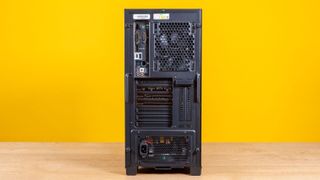
Apart from the aforementioned front-panel ports, the MSI Z390 A-Pro motherboard delivers about what you’d expect around back. You get two USB 2.0 ports and one PS/2 for peripherals, along with a pair of USB 3.1 Gen 2 (one Type-A and one Type-C), two more USB 3.1 Gen 1 ports, 7.1 Surround Audio (Realtek’s ALC892 Codec) and a Gigabit Ethernet port.
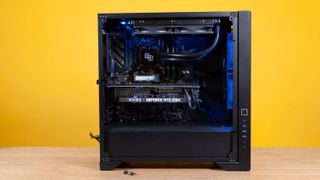
The board doesn’t include Wi-Fi, but Maingear includes a tiny TP-Link USB adapter for those moments (like when troubleshooting or upgrading) when you might need connectivity but aren’t near an Ethernet cable. That said, there’s no Bluetooth included, so if you have wireless peripherals that use that protocol, you’ll need yet another adapter.

Given that the Vybe is made of off-the-shelf parts (apart from the case), there are a fair amount of upgrade options. Four of the six SATA ports are empty, and there are mounts for 2.5-inch drives both on top of the PSU cover as well as behind the motherboard. And there are a pair of PCIe x1 slots and a second PCIe x16 slot all empty and blocked by the bulky EVGA graphics card. Note, though, that the graphics card does get quite close to the second x16 slot, so whatever you install there is going to be tight.
Gaming and VR Performance
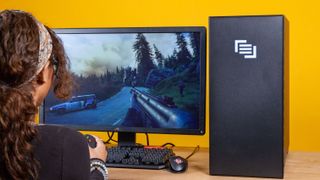
We pitted Maingear’s Vybe against a couple of smaller powerhouse desktops, MSI’s Trident X and Corsair’s One i160, as well as the somewhat larger Alienware Aurora R8. Most of these machines landed on our test bench with an Nvidia RTX 2080 and either an Intel Core i7 or Core i9 CPU. But the Corsair packs a higher-end RTX 2080 Ti, along with liquid cooling on both the CPU and graphics card. That will likely give it an edge in gaming, but at $3,699, it’s also $1,200 pricier than the Stage 4 Vybe.
The RTX 2080 in this configuration of the Vybe sits one step below the company’s absolute top-end consumer card (the $1,000-plus RTX 2080 Ti), but it’s certainly no performance slouch. And Maingear has paired it here with the Core i9-9900K, a flagship CPU that, while overkill from a purely gaming perspective, should be able to squeeze the maximum frame rates possible from the Nvidia card.
I played through a demon-packed portion of the Kadingir Sanctum level in Doom at 4K resolution and Ultra settings, and the frame rates hovered between 86 and 122 frames per second (fps). During the gaming session, the Vybe’s fans got noticeably louder, but still remained fairly muted, sounding more like a collective, persistent whir of airflow, rather than the loud or pitch-changing fan noise I’ve heard from many other gaming desktops over the years.



In Shadow of the Tomb Raider, the Vybe edged out the competing RTX 2080 systems from MSI and Alienware. But the more powerful (and much pricier) Corsair machine with its RTX 2080 Ti was the clear leader. The Vybe also fell just behind the gaming desktop category average on this test, thanks to a wave of recent 2080 Ti rigs landing on our test bench.
The Vybe managed to edge out the category average on Grand Theft Auto V in 1080p, as well as besting the MSI and Alienware rigs. But the Corsair One i160 was again the obvious winner on this test.
Hitman saw the Vybe looking its most impressive in our gaming tests, pulling substantially ahead of the Alienware- and MSI-made competition. It even got close to the Corsair One at 1080p, while pulling nearly 45 fps ahead of the category average at that resolution. Again, you're witnessing the Core i9 CPU pushing the maximum possible frame rates out of the RTX 2080 here. And that CPU will play a much bigger role in our next section.
On our stress test, in which we run Metro: Last Light 10 times in a row, the Vybe's i9-9900K averaged a clock speed of 4.9 GHz and a temperature of 62.2 degrees Celsius (144 Fahrenheit). The GPU temperature averaged 67 degrees Celsius (153 Fahrenheit). Both temperatures are well within the tolerances of the respective silicon, so there should be no throttling issues while gaming.
Productivity Performance
The Core i9 processor in the Vybe should give it an edge in some of our productivity tests, thanks to its 8 physical cores and 16 computing threads. But its Intel 660p NVMe SSD, while speedy compared to SATA-based drives, is far from the fastest NVMe SSD you can buy. Let’s see how the pairing works out for Maingear in terms of productivity abilities.



Things start out strong for the Vybe on Geekbench 4. Its score of 34,738 puts it well ahead of even the Corsair One i160 and nearly 5 percent ahead of the gaming desktop category average.
But things didn't look quite as good for the Maingear machine on our the 4.97GB file transfer test. Its 462.7MB per second average beat out the MSI Trident X, but the Alienware and Corsair systems were much faster. That said, these differences don't generally translate to noticeable real-world use unless, say, you're copying large amounts of files onto the SSD from a drive that's just as fast. For general use and gaming, the 660p SSD is plenty speedy.
On our Handbrake test, in which we use the program to transcode a 4K video to 1080p, the Vybe was oddly bested by the MSI Trident X, although Maingear's machine was able to beat everything else in this comparison, finishing 11 seconds ahead of the Corsair system, far ahead of the Alienware and nearly a minute faster than the category average. Of course, this being a K-series CPU, you can also overclock the processor to eke out more performance. And the 240mm liquid cooler, roomy case and five internal fans should help on that front as well. But the increased thermals of an overclocked PC will mean that the Vybe won’t be as quiet as it is at stock settings.
Software and Warranty
As noted earlier, Maingear makes a point that the Vybe ships with no bloatware. That’s true in regards to third-party software, although there is a fair bit of unavoidable cruft that comes included with Windows 10 these days, like various Candy Crushes, Netflix and Fitbit Coach.
Maingear ships the Vybe with a one-year warranty and lifetime service labor and phone support.
Pricing and Configuration
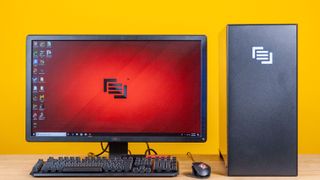
Our $2,499 Vybe review unit is the top-end pre-configured option, which includes an i9-9900K, an RTX 2080 (EVGA in our unit, but Maingear doesn’t specify a brand on its product page), 16GB of HyperX memory and both a 512GB Intel 660p NVMe SSD and 2TB hard drive.
While the storage loadout should serve gamers well enough, given that the 660p is currently selling for just $70 for the 512GB model in this system and just $110 for the 1TB model, I’d like to see a roomier SSD. But then, I’m not exactly happy with the choices most companies make when it comes to the boot drive these days. You can at least upgrade to the Stage 4 Boost configuration, which doubles the RAM and boot drive capacity, for an extra $250.
The Stage 3 configuration of the Vybe, which the company aims at QHD gamers, sports a Core i5-9600K and an RTX 2060, while the two lower-end options both ship with AMD CPUs. The Stage 2 ($1,049) has a Ryzen 5 2600 and an Nvidia GTX 1660 Ti (aimed at 1080p gamers), while the esports-focused $699 Stage 1 runs on a Raven Ridge Ryzen 5 2400G with integrated Vega 11 graphics.
Of course, this being Maingear, you can configure the Vybe with all manner of PC hardware and expensive paint jobs. The company’s custom Apex cooling is also an option (for between $650 and $900), although choosing that takes the quick-shipping option off the table. Apex cooling installation requires a four-week lead time, according to the company’s configurator page. Coincidentally, that’s about how long I’d have to save up to be able to afford it.
At the very least, Maingear isn’t charging an exorbitant fee for assembling the Vybe. When I priced out the same or similar components to the $2,499 Stage 4 model on Newegg, my shopping cart had nearly $2,300 worth of components in it.
Sure, you could build your own system and save a couple hundred bucks. But to do as nice a job with wiring as Maingear has here, you’re going to spend hours doing so. And if something goes wrong after you’re up and running, you’ll have to do your own diagnosing and might have to reach out to a number of companies for service, all of them likely outside the U.S. With a pre-built system like the Vybe, if something goes awry, you can pick up the phone and get U.S.-based support. Whether or not that’s worth a couple hundred dollars to you depends on your patience and expertise.
Bottom Line

For those looking for an understated, powerful gaming and productivity PC that isn’t overly flashy, Maingear’s Vybe Stage 4 is a solid, if not particularly exciting, choice. Its performance is good, the price is quite reasonable for the parts and the cooling setup kept temps under control without ever approaching an offending level of fan noise.
A lesser Core i7 CPU would have arguably been a smarter CPU choice for gamers, which would let Maingear spend more on the boot drive and the case (or just lower the asking price), but that’s a minor quibble for what’s otherwise a cleanly built, powerful and quiet PC.
Photo Credits: Tom's Hardware
MORE: Best Gaming Desktops
MORE: How To Build A PC
MORE: All PC Builds Content
After a rough start with the Mattel Aquarius as a child, Matt built his first PC in the late 1990s and ventured into mild PC modding in the early 2000s. He’s spent the last 15 years covering emerging technology for Smithsonian, Popular Science, and Consumer Reports, while testing components and PCs for Computer Shopper, PCMag and Digital Trends.
